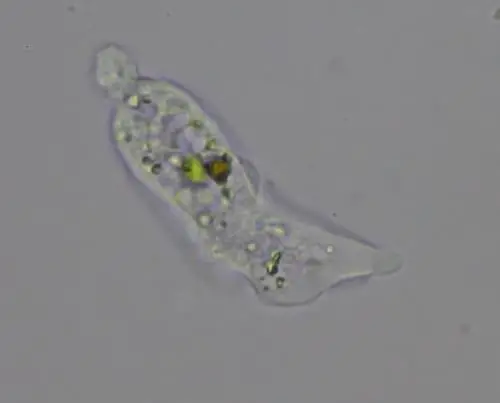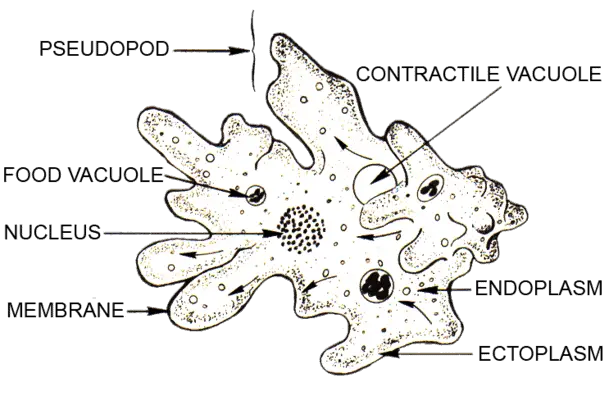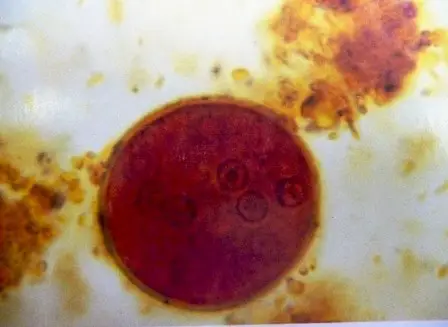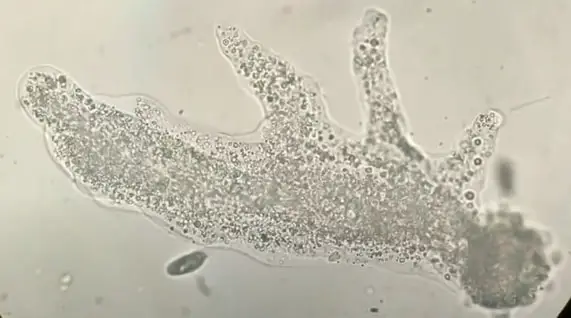All living organisms are composed of cells. While humans have 37 trillion, there are also living things composed of only one cell. They are called unicellular organisms and one good example of these are the amoebas.
Amoebas are very small single-celled organisms (250-750 microns) known to live in freshwaters, such as rivers, ponds, and lakes. Amoebas use pseudopodia, which are finger-like formations, to move very slowly from one place to another and capture food for consumption. Sometimes, Amoeba can even make it inside the human body and cause diseases.
In this post we will look at some distinct features of Amoebas, their cellular structure, lifecycle, and so much more!
Scientific Classification

Amoebas belong to the Kingdom Protista and are considered protozoans that solely get their nutrition from other organisms. They are not animals, plants nor fungi. However, they are still classified as eukaryotes because of their nuclei and membrane-bound organelles.
Here is a detailed taxonomic classification of amoebas (ITIS, 2020):
- Domain: Eukarya
- Kingdom: Protozoa
- Phylum: Protozoa
- Subphylum: Sarcodina
- Superclass: Rhizopoda
- Class: Lobosa (amoebas, amibes)
- Order: Amoebida
- Families: Amoebidae, Entamoebidae, Acanthamobidae, Hartmannallidae
Cell Structure
The term amoeba is from the Greek word amoibe which means“to change”. These microscopic organisms are often called “shape-shifters” as they have the ability to constantly change their shape.
In fact, one of their distinguishing features is the formation of temporary finger-like extensions called pseudopods. These pseudopods, or false feet, enable the amoeba to move about. This movement is known as amoebic movement and is considered to be the most primitive form of locomotion.
To be able to understand the movement and the life of an amoeba, it is but necessary to familiarize yourself with the parts of this amazing single-celled organism. Like all eukaryotic cells, amoeba’s cell structure includes the nucleus, cytoplasm, organelles, and plasma membrane (Bovee, 1953).

Plasma Membrane
The plasma membrane covers the whole body of the amoeba. It gives the amoeba shape and keeps the organelles inside the cell. It is also thin and elastic and can produce pseudopodia easily.
Cytoplasm
An amoeba’s cytoplasm can be divided into two parts: the outer ectoplasm and the inner endoplasm.
Ectoplasm
Immediately after the plasma membrane is the ectoplasm. It is a thick, non-granular, and contractile layer of the cytoplasm that maintains the shape of the amoeba. It also helps form the pseudopodia.
Endoplasm
The granular and less viscous part of the cytoplasm is the endoplasm. While this layer also helps in the production of pseudopodia, it mainly contains the organelles of the cell and performs physiological functions.
Organelles
Pseudopodia
The presence of pseudopodia or pseudopod is what unites amoeba species and sets them apart from other protists. These can form from any part of the amoeba. They are finger-like extensions formed due to the pushing of the cytoplasm inward or outward. Pseudopodia are used for both movement and eating.
As for locomotion, imagine the simultaneous formation of pseudopodia that propels the amoeba to the direction it wants to go to. It’s a movement somewhat similar to crawling. As for eating, amoebas ingest their food by encircling and engulfing them.
Vacuoles
Contractile Vacuole: helps excrete excess water and carbon dioxide and thus, maintains the osmotic pressure.
Food Vacuole: surrounds the food and helps in its digestion, storage, and excretion. The number of food vacuoles depends on the amount of food eaten by the amoeba.
Water Vacuole: stores water and keeps the water balance of the cell.
Nucleus
The nucleus contains all the genetic material of the amoeba. This genetic material is like a code or an instruction manual of how an organism is structured and how it behaves. Thus, the nucleus is in charge of the growth, reproduction, and all the cell functions of the amoeba. The number of nuclei inside the cell depends on the species of the amoeba.
Other Organelles
There are other amazing organelles in Amoebas. For more details on each of them see the posts below.
Where do Amoebas Live?
Different species of amoeba can be found all over the world. They are usually found in the decaying vegetation in the bottom of water bodies such as lakes, ponds, slow-flowing rivers, springs and ditches.

How do Amoebas Move?
Amoeba move by amoeboid movement, propelling forward in a crawling or sliding motion. While this movement is characteristic of protozoan amoeba, it is also a common mode of locomotion for most eukaryotic cells. In fact, our white blood cells, the cells that help fight infections in our body, move toward infected sites through this movement.
Like our white blood cells, amoeba move by extending its cytoplasm and changing its shape. The cytoplasm is continually changing and flowing forward into the finger-like pseudopods. The inner endoplasm flows forward in the cell due to the pressure from the outer ectoplasm. The fluid will flow to form a pseudopod. Once the endoplasm reaches the end of it, the fluid will be forced back by the ectoplasm. This continuous change from gel to fluid and the forward and backward motion propels the amoeba towards the direction it wishes to go.
How do Amoebas Eat?
In an actively motile and feeding state, amoebas are said to be in their trophozoite form. An amoeba’s food can be other protists (e.g. paramecium) or bacteria. When they find these in their environment, they use their pseudopods to encircle the food, engulf it and take it inside themselves to form food vacuoles. This process is called phagocytosis.
The digestive chemicals inside the cell will then breakdown the food material. Nutrients will be absorbed by the amoeba and unacceptable food will be excreted. Below is an example of an amoeba engulfing a paramecium.
How do Amoebas “Breathe”?
Like humans, amoebas needs oxygen for all its cellular processes, especially energy generation. Unlike humans, though, they do not have noses or lungs. Instead, they “breathe” through their plasma membrane. Because amoebas mostly live in an aquatic or moist environments, dissolved oxygen would just pass through its plasma membrane, in a process called diffusion.
The oxygen will go towards the mitochondria, the power-plant of the cell. This, together with the nutrients from food, will be processed to provide energy for the amoeba. Waste products from respiration, such as carbon dioxide and other nitrogenous waste are also excreted through diffusion.
How do Amoebas Reproduce?
Unlike humans, amoebas are unicellular cells and they usually reproduce asexually by binary fission. This just means that one cell will split in half and produce two identical cells. The process can be described in detail by the following steps.
Division of the Nucleus
As you may remember, the nucleus contains the genetic material of the amoeba. When it is time for the amoeba to reproduce, this genetic material is replicated to form a copy of the original. The nucleus elongates until two daughter nuclei are formed. This process is called binary fission.
Division of the Cytoplasm
As the nucleus elongates, the cytoplasm around it also elongates until it is pinched in half. This process is called cytokinesis.
Formation of two Daughter Cells
The two daughter cells form after the division of the parent amoeba cell. They contain their own nucleus and organelles but are the exact clones of the parent cell.
Are Amoebas Immortal?
Can you believe that the very first amoeba on Earth from a thousand years ago is still somehow with us today? This is because of its mode of reproduction. With binary fission, the first amoeba became its two clones and then four clones, and so on, with the same exact genetic material, except in cases of mutation.
While the common amoeba’s lifespan is about two days (which just means it divides every two days), we cannot say that it died. This is because its clone is still alive (Ahmed Khan, 2015). Amoeba can only die with active intervention like drugs (e.g. Flagyl) or anti-microbial agents. During adverse environmental conditions, amoebas can become a cyst.
During this encystment, amoebas lose most of its water and a membrane forms to protect it. In cyst form, amoebas can survive, and thus, natural death is impossible for them. When the conditions are again optimal, the cyst ruptures and the amoeba emerges again.
Common Amoeba Species
Amoeba classified under the order of Amoebida are mostly free-living protozoans in water bodies and moist soil, basically everywhere! Smaller members feed on bacteria while bigger ones eat algae and other protozoans. While most of them are free-living, they can also be parasites to humans. Some may cause disease while some do not harm their host.
Amoebas that Will Not Make You Sick
When you hear the word amoeba, what is the first thing that comes to mind? Probably stomachaches and diarrhea, right? Despite that, it is important to know that protozoans that are known as “amoeba” is actually a group of different organisms. Apart from being unicellular and moving by pseudopodia, they have various life cycles and needs to survive. To be a parasite means that the organism lives in a host for its own benefit.
However, it does not always mean that they harm their host in the process. There are some species of amoeba characterized as “non-pathogenic” which means they will not harm humans, even those who are vulnerable to diseases.
The Commensals
Entamoeba coli, Entamoeba hartmanni, Entamoeba dispar and Endolimax nana
These are examples of commensal parasites to humans. Though they get their nutrition from their human hosts, they also exhibit a commensal relationship with it. This means it is a one-sided symbiotic relationship. The amoeba benefits but the human is not affected in any way.
Cysts and trophozoites of these amoebae can be seen in stool-contaminated food or water. Once ingested, they migrate to the large intestine where they can be passed in the feces once again.

Your Giant Friend in Biology Class
Amoeba proteus
Distinguishing feature: 500-1000 micrometers in size, almost visible to the naked eye Due to its large size and typical structure, Amobae proteus is widely used in science classrooms and laboratories. They are used to observe the parts of the cell, pseudopods and cell division.
While they can be easily ordered from supply companies, they are abundantly found in nature. Amoeba can be found in fresh-water habitats like ponds, ditches, and puddles with aquatic plants.
Amoebas that Might Make You Sick
Entamoeba Histolytica

Prevalence: Amebiasis is an intestinal infection caused by Entamoeba histolytica. All over the world, about 50 million people get sick with amebiasis (Shirley, 2018) and 55,000 people die from it each year. It is prevalent in tropical countries and countries where there are not enough barriers between human feces and food and water supply.
How one gets infected: One can get amebiasis by eating, drinking or swallowing something with Entamoeba histolytica cysts. Amoeba, in general, exists as a motile trophozoite or as a cyst that can withstand any adverse environment. Cysts are passed with the stool of people with the disease and if the sanitation condition is poor, feces with Entamoeba histolytica can contaminate drinking water, food or hands.
Excystation or the release of motile trophozoites from the protective cysts occur in the small intestine. These motile amoebae (remember their pseudopods?) will then migrate to the large intestine where they undergo binary fission, multiply and form cysts to be passed with poop.
Symptoms: Out of 100 people who have Entamoeba histolytica in their large intestine, only 10-20 people will experience symptoms. Symptoms usually develop two to four weeks after contracting the amoeba.
- Mild: diarrhea, fever, dehydration
- Amebic dysentery: stomach pain, severe diarrhea (sometimes with blood), fever
- Rare: invasion of the liver leading to formation of pus
Diagnosis: Health care providers usually request for stool samples. However, diagnosis of amebiasis is not always definite because E. histolytica can look like other cells under the microscope. Entamoeba dispar, a commensal amoeba, can look very similar to E. histolytica. Tests to differentiate these species are not yet widely available in laboratories. If a person is experiencing symptoms of amebiasis amoeba is seen in the poop, it is usually best to assume that it is an E. histolytica infection.
Treatment: Patients with symptomatic amebiasis are given antibiotics, specifically metronidazole and tinidazole. They can be either taken by mouth or injected into the veins. For people who do not exhibit symptoms but pass amoeba cysts with the stool, they can be given luminal drugs. These are iodoquinol, paromomycin, and furoate.
Prevention: There are no vaccines available for amebiasis. If you travel or stay in places where amoebas are common, it is best to be cautious about your food and drinks. Only drink sealed bottled water or water you’ve boiled yourself. Avoid beverages with ice cubes and food sold by street vendors. Eat only thoroughly cooked food and wash your hands frequently.
Naegleria Fowleri
Naegleria fowleri is a freshwater amoeba that causes a rare but fatal brain disease called primary amebic meningoencephalitis (PAM). This amoeba can survive in warm temperatures, until 46°C, and are commonly found in warm lakes, ponds and hot springs.
Prevalence: Naegleria fowleri is a common amoeba in warm waters and millions of people get exposed yearly. Of these people who get exposed, only a few get infected. According to the Centers for Disease Control and Prevention (CDC, 2019), from 2009-2018, only 34 people in the United States were infected. That’s not too scary, right? The bad news is once a person is infected, there is a 97% chance of dying.
How one gets infected: N. fowleri usually feed on bacteria in its natural habitat until it accidentally finds its way to the nose of a swimmer. It is important to note that you cannot be infected if you drink water contaminated with N. fowleri. However if itmakes its way inside the nose, it can travel through the nerve of the nose towards the brain. In the brain, the amoeba will start feeding on brain cells. This causes swelling and will eventually lead to the death of brain tissue.
Symptoms: The PAM caused by N. fowleri is almost always fatal. Symptoms start after a day to 9 days after the exposure, e.g. swimming. After the symptoms appear, it only takes 1-18 days for the infected person to die.
Stage 1: Fever, nausea, vomiting and severe headache on the front
Stage 2: Stiff neck, hallucinations, confusion, coma
Diagnosis: It typically takes weeks to detect that a patient has PAM since there is still no rapid test to detect an N. fowleri infection. It is also very similar to brain infections caused by bacteria.
Treatment: Though PAM has historically been very fatal, there are 5 well-documented survivors out of the 145 people who were infected with N. fowleri. A treatment protocol with a drug called miltefosine in combination with other drugs that lowers the body temperature has been successful (Travis W. Heggie, 2017).
Prevention: Since infections happen when N. fowleri comes up the nose, a good preventive measure is to avoid submerging your head underwater when swimming in warm waters or during summer. If it is unavoidable, a nose clip would also came in handy. There are also cases where the infection came from contaminated tap water, so do not cleanse your nostrils with tap water.
Acanthamoeba
Acanthamoeba can be found everywhere, in water and soil. We are exposed to them all the time but they rarely cause disease. However, there are about 20 different species of the Acanthamoeba family that have been linked to human disease (Siddiqui, 2012). They can cause acanthamoeba keratitis, an infection in the eyes and granulomatous amebic encephalitis (GAE), an infection of the brain and spinal cord.
Acanthamoeba in the eye: Acanthamoeba keratitis is a rare eye condition that could happen when acanthamoeba-contaminated soil, water or contact lens solution come in contact with the outer covering of the eye (cornea). Infected people experience redness of the eye, eye pain and blurred vision which can eventually lead to visual impairment or blindness.
Early diagnosis is key to treating acanthamoeba keratitis since prescription drugs are available. People who wear contact lenses should properly disinfect their hands before putting the lenses on. Also, avoid putting on contact lenses when swimming, going in a hot tub, or even showering.
Acanthamoeba in the brain: Another rare but fatal acanthamoeba-related disease is granulomatous amebic encephalitis (GAE). This amoeba can enter the body through cuts in the skin or through the nose. Acanthamoeba can then go to the blood circulation and eventually go to the brain where it will feed on the brain and spinal cord tissue.
Those who can are at risk of GAE include people with weak immune systems (e.g. very old people or AIDS) and those with other diseases (e.g. diabetes, malnutrition, cancer). Patients with GAE experience headaches, neck stiffness, seizures and coma. Because of its rarity and similarity to other bacterial or viral brain infections, it is hard to diagnose. There are medicines that can be used to treat this condition, but they are not always successful.
Interesting Facts
Amoeba can stick together and form a multicellular (and smart!) “slime mold”.
When food is scarce, amoebae come together to form a moving blob called a slime mold. They change shape, function, release spores and adapt to their environment. They do not randomly get in contract with food, they behave like microscopic engineers, changing their structure and functions to survive and thrive (Bonner, 2009).
Amoebas’ “simplicity” give insight into our complexity.
The unicellular amoeba has about 15,000 genes that code for proteins while humans have 23,000 (Andrew J. Heidel, 2011). This tells us that the complexity we have now is already present millions of years before and gives us great insight into evolutionary considerations.
Takeaways
The amoebae are indeed amazing unicellular organisms. Despite their very simple structure, they are able to do some very advanced things like eat, move, adapt, communicate, and survive in harsh environments. The next time you see a pond I hope you have a greater appreciation for some of the amoeba that may be hanging out in there!
References
- ITIS. (2020, January 17). Amoebida. Retrieved from Integrated Taxonomic Information System: https://www.itis.gov/servlet/SingleRpt/SingleRpt?search_topic=TSN&search_value=43851#null
- Bovee, E. C. (1953). Morphological Identification of Free-Living Amoebida. Proceedings of the Iowa Academy of Science, 599-615.
- Ahmed Khan, N. B. (2015). The immortal amoeba: a useful model to study cellular differentiation processes?. , 109(7), 305–306. . Pathogens and global health, 109(7), 305–306. https://doi.org/10.1080/20477724.2015.1103504.
- Shirley, D. T. (2018). A Review of the Global Burden, New Diagnostics, and Current Therapeutics for Amebiasis. Open forum infectious diseases(5), 7. https://doi.org/10.1093/ofid/ofy161.
- CDC. (2019, March 28). Parasites — Naegleria fowleri — Primary Amebic Meningoencephalitis (PAM) — Amebic Encephalitis. Retrieved from Centers for Disease Control and Prevention: https://www.cdc.gov/parasites/naegleria/general.html
- Travis W. Heggie, T. K. (2017). Surviving Naegleria fowleri infections: A successful case report and novel therapeutic approach. Travel Medicine and Infectious Disease, 16, 49-51 ISSN 1477-8939, https://doi.org/10.1016/j.tmaid.
- Siddiqui, R. K. (2012). Biology and pathogenesis of Acanthamoeba. Parasites Vectors, 5, 6 https://doi.org/10.1186/1756-3305-5-6.
- Smirnov, A. (2009). Amoebas, Lobose. In Encyclopedia of Microbiology. Elsevier.
- Bonner, J. (2009). The Social Amoebae. In The Biology of Cellular Slime Molds. Princeton Univ Press, Princeton.
- Andrew J. Heidel, H. M. (2011). Phylogeny-wide analysis of social amoeba genomes highlights ancient origins for complex intercellular communication. Genome research, 21, 1882-1891.

